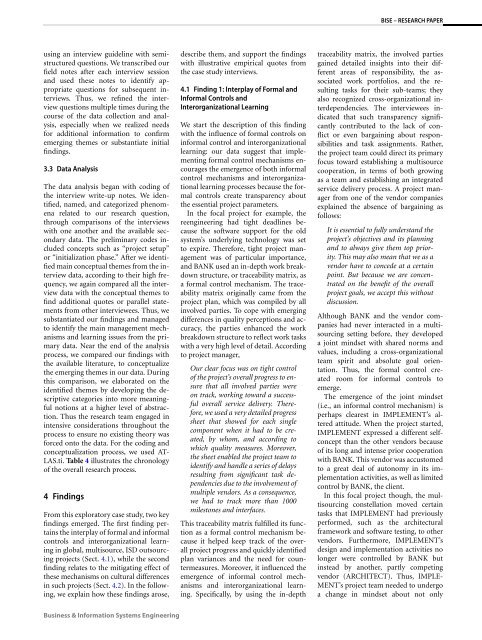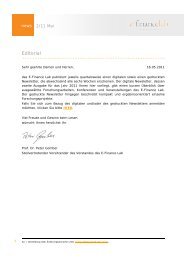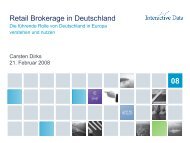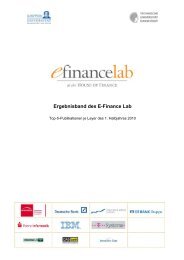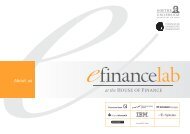Prof. Dr. Wolfgang König, Prof. Dr.-Ing. Ralf ... - E-Finance Lab
Prof. Dr. Wolfgang König, Prof. Dr.-Ing. Ralf ... - E-Finance Lab
Prof. Dr. Wolfgang König, Prof. Dr.-Ing. Ralf ... - E-Finance Lab
You also want an ePaper? Increase the reach of your titles
YUMPU automatically turns print PDFs into web optimized ePapers that Google loves.
using an interview guideline with semistructured<br />
questions. We transcribed our<br />
field notes after each interview session<br />
and used these notes to identify appropriate<br />
questions for subsequent interviews.<br />
Thus, we refined the interview<br />
questions multiple times during the<br />
course of the data collection and analysis,<br />
especially when we realized needs<br />
for additional information to confirm<br />
emerging themes or substantiate initial<br />
findings.<br />
3.3 Data Analysis<br />
The data analysis began with coding of<br />
the interview write-up notes. We identified,<br />
named, and categorized phenomena<br />
related to our research question,<br />
through comparisons of the interviews<br />
with one another and the available secondary<br />
data. The preliminary codes included<br />
concepts such as “project setup”<br />
or “initialization phase.” After we identified<br />
main conceptual themes from the interview<br />
data, according to their high frequency,<br />
we again compared all the interview<br />
data with the conceptual themes to<br />
find additional quotes or parallel statements<br />
from other interviewees. Thus, we<br />
substantiated our findings and managed<br />
to identify the main management mechanisms<br />
and learning issues from the primary<br />
data. Near the end of the analysis<br />
process, we compared our findings with<br />
the available literature, to conceptualize<br />
the emerging themes in our data. During<br />
this comparison, we elaborated on the<br />
identified themes by developing the descriptive<br />
categories into more meaningful<br />
notions at a higher level of abstraction.<br />
Thus the research team engaged in<br />
intensive considerations throughout the<br />
processtoensurenoexistingtheorywas<br />
forced onto the data. For the coding and<br />
conceptualization process, we used AT-<br />
LAS.ti. Table 4 illustrates the chronology<br />
of the overall research process.<br />
4Findings<br />
From this exploratory case study, two key<br />
findings emerged. The first finding pertains<br />
the interplay of formal and informal<br />
controls and interorganizational learning<br />
in global, multisource, ISD outsourcing<br />
projects (Sect. 4.1), while the second<br />
finding relates to the mitigating effect of<br />
these mechanisms on cultural differences<br />
in such projects (Sect. 4.2). In the following,<br />
we explain how these findings arose,<br />
Business & Information Systems Engineering<br />
describe them, and support the findings<br />
with illustrative empirical quotes from<br />
the case study interviews.<br />
4.1 Finding 1: Interplay of Formal and<br />
Informal Controls and<br />
Interorganizational Learning<br />
We start the description of this finding<br />
with the influence of formal controls on<br />
informal control and interorganizational<br />
learning: our data suggest that implementing<br />
formal control mechanisms encourages<br />
the emergence of both informal<br />
control mechanisms and interorganizational<br />
learning processes because the formal<br />
controls create transparency about<br />
the essential project parameters.<br />
In the focal project for example, the<br />
reengineering had tight deadlines because<br />
the software support for the old<br />
system’s underlying technology was set<br />
to expire. Therefore, tight project management<br />
was of particular importance,<br />
and BANK used an in-depth work breakdown<br />
structure, or traceability matrix, as<br />
a formal control mechanism. The traceability<br />
matrix originally came from the<br />
project plan, which was compiled by all<br />
involved parties. To cope with emerging<br />
differences in quality perceptions and accuracy,<br />
the parties enhanced the work<br />
breakdown structure to reflect work tasks<br />
with a very high level of detail. According<br />
to project manager,<br />
Our clear focus was on tight control<br />
of the project’s overall progress to ensure<br />
that all involved parties were<br />
on track, working toward a successful<br />
overall service delivery. Therefore,<br />
we used a very detailed progress<br />
sheet that showed for each single<br />
component when it had to be created,<br />
by whom, and according to<br />
which quality measures. Moreover,<br />
the sheet enabled the project team to<br />
identify and handle a series of delays<br />
resulting from significant task dependencies<br />
due to the involvement of<br />
multiple vendors. As a consequence,<br />
we had to track more than 1000<br />
milestones and interfaces.<br />
This traceability matrix fulfilled its function<br />
as a formal control mechanism because<br />
it helped keep track of the overall<br />
project progress and quickly identified<br />
plan variances and the need for countermeasures.<br />
Moreover, it influenced the<br />
emergence of informal control mechanisms<br />
and interorganizational learning.<br />
Specifically, by using the in-depth<br />
BISE – RESEARCH PAPER<br />
traceability matrix, the involved parties<br />
gained detailed insights into their different<br />
areas of responsibility, the associated<br />
work portfolios, and the resulting<br />
tasks for their sub-teams; they<br />
also recognized cross-organizational interdependencies.<br />
The interviewees indicated<br />
that such transparency significantly<br />
contributed to the lack of conflict<br />
or even bargaining about responsibilities<br />
and task assignments. Rather,<br />
the project team could direct its primary<br />
focus toward establishing a multisource<br />
cooperation, in terms of both growing<br />
as a team and establishing an integrated<br />
service delivery process. A project manager<br />
from one of the vendor companies<br />
explained the absence of bargaining as<br />
follows:<br />
It is essential to fully understand the<br />
project’s objectives and its planning<br />
and to always give them top priority.<br />
This may also mean that we as a<br />
vendor have to concede at a certain<br />
point. But because we are concentrated<br />
on the benefit of the overall<br />
project goals, we accept this without<br />
discussion.<br />
Although BANK and the vendor companies<br />
had never interacted in a multisourcing<br />
setting before, they developed<br />
a joint mindset with shared norms and<br />
values, including a cross-organizational<br />
team spirit and absolute goal orientation.<br />
Thus, the formal control created<br />
room for informal controls to<br />
emerge.<br />
The emergence of the joint mindset<br />
(i.e., an informal control mechanism) is<br />
perhaps clearest in IMPLEMENT’s altered<br />
attitude. When the project started,<br />
IMPLEMENT expressed a different selfconcept<br />
than the other vendors because<br />
of its long and intense prior cooperation<br />
with BANK. This vendor was accustomed<br />
to a great deal of autonomy in its implementation<br />
activities, as well as limited<br />
control by BANK, the client.<br />
In this focal project though, the multisourcing<br />
constellation moved certain<br />
tasks that IMPLEMENT had previously<br />
performed, such as the architectural<br />
framework and software testing, to other<br />
vendors. Furthermore, IMPLEMENT’s<br />
design and implementation activities no<br />
longer were controlled by BANK but<br />
instead by another, partly competing<br />
vendor (ARCHITECT). Thus, IMPLE-<br />
MENT’s project team needed to undergo<br />
a change in mindset about not only


